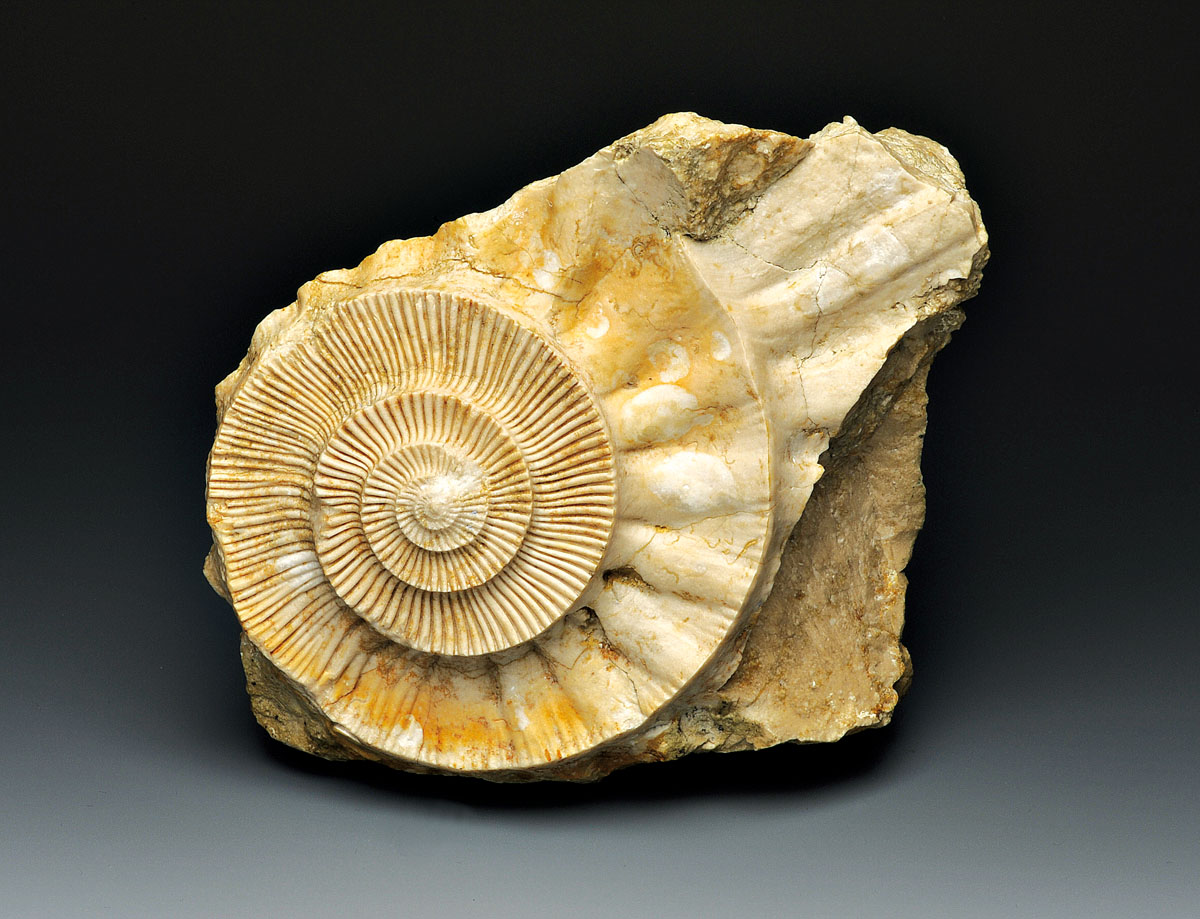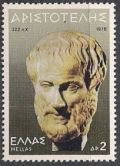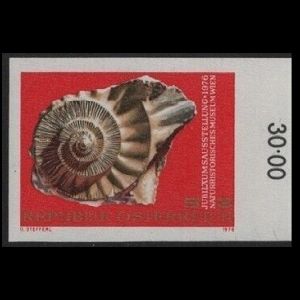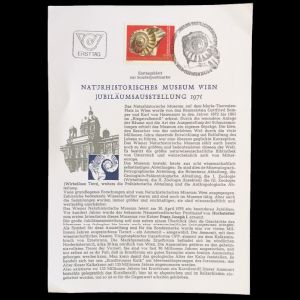Austria 1976 "100th anniversary of the Vienna Natural History Museum - Jubilee exhibition"
| <prev | back to index | next> |
| Issue Date | 30.04.1976 |
| ID | Michel: 1510 (1501F - gold colour, country name and value, omitted), Scott: 1032, Stanley Gibbons: 1757, Yvert & Tellier: 1339, Category: pF |
| Designer | Otto Steeferl |
| Stamps in set | 1 |
| Value | s3 - Ammonite (Virgatosphinctes transitorius/Ernstbrunnia fasciculata) |
| Emission/Type | commemorative |
| Issue place | Vienna 1150 |
| Size (width x height) | 39mm x 30mm |
| Layout | 50 stamps in sheet (5x10) |
| Products | FDC x1 |
| Paper | White Postage stamps paper |
| Perforation | 13,75x14.50 |
| Print Technique | Photogravure, multicolor |
| Printed by | Österreichische Staatsdruckerei (Austrian State Printing Office) |
| Quantity | 3,250,000 |
| Issuing Authority | Austrian Post |

On 30th April, 1976, the Post of Austria, issued the stamp "100th anniversary of the Vienna Natural History Museum - Jubilee exhibition".
On this day, the Vienna Natural History Museum celebrated a special anniversary. A hundred years ago, the well-known New Zealand's explorer Ferdinand von Hochstetter was appointed the first director of the museum by Emperor Franz Joseph I.
The large anniversary exhibition was intended to provide an overview of the history of the Museum from its beginning until today (1976) while also providing a scientific presentation.
An Ammonite was selected as a symbol for the exhibition and for the postage stamp. The stamp shows an impression of the Ammonite (not the actual shell), an external mold, with partially exposed juvenile whorls. When the stamp was issued, the Ammonite species was called Virgatosphinctes transitorius, but later on it was reassigned to a new species - Ernstbrunnia fasciculata which is valid to date.
In 2001 German paleontologist Arnold Zeiss (1928-2020) published a review of the Ammonite Fauna of Ernstbrunn - "Die Ammonitenfauna der Tithonklippen von Ernstbrunn, Niederösterreich" (in English: The ammonite fauna of the Tithon cliffs at Ernstbrunn, Lower Austria). He defined three new genera, including Ernstbrunnia and six new species, including Ernstbrunnia fasciculata. Zeiss explained that the same Ammonite from Ernstbrunn was described in different publications by different names, mostly as Virgatosphinctes transitorius (Bachmmayer, Thenius and Hofman ...), but he assigned it to new genus Ernstbrunnia and name the species as Ernstbrunnia fasciculata - the holotype of the species is the fossil used as source for the stamp (Zeiss even mentioned the stamp in his work).

|
| Fossil of Ernstbrunnia fasciculata Ammonite. Image credit: "Meeresstrand und Mammutwiese" by Thomas Hofmann, Mathias Harzhauser, Reinhard Roetzel, ISBN 978-3-9504625-5-5. |
The Ammonite species named after the small town of Ernstbrunn, 50 km north of Vienna, in the district of Korneuburg in Lower Austria, with population of about 3200. This small town gave its name not only to the Ammonite, but also to limestone strata - the Ernstbrunn Limestone. The strata have been identified from several drillings and belong to a Middle Tithonian (152-145 million ago) to Berriasian age (145-139 million years ago) of Mesozoic era. The rock record provides evidence for lagoonal and patch reef facies and fringing ooid-oncoid bars, all attributed to the Ernstbrunn Limestone. The lagoonal limestones preserve a megadiverse, mollusc-dominated assemblage of more than 500 species of invertebrates and calcareous algae. The most abundant taxa include Heterodiceras and Epidiceras bivalves (basal rudists), nerineid gastropods, decapods, ammonites, corals, and Dasycladacean algae.
The first fossil from the strata was reported by Austrian mineralogist and geologist Karl Haidinger (1756-1797) in 1782, who unearthed an epidiceratid bivalve from the carbonates of the Semmelberg near Ernstbrunn.
It took almost 50 more years, until geological investigations on the Ernstbrunn Limestone started. In 1830 it was Ami Boué, who “painted” a first picture of these carbonates in his “Geognostisches Gemälde von Deutschland” (Boué 1829) and established the term “Calcaire d’Ernstbrunn” (= Ernstbrunn Limestone) in his follow-up article on the Mesozoic stratigraphy of the “Austrian Alps” (Boué 1830). The first Ammonite was collected from the Ernstbrunn Limestone by von Abel in 1899 and described by Marianne Möller in 1911. Since then, many famous Austrian and Czech geologists have contributed to the discussion about the nature and origin of the enigmatic Upper Jurassic hill chain that occurs to the north of Vienna, between the Danube and Thaya rivers.
The same design, as the postage stamp, appeared on an advertising postmark for the village of Ernstbrunn in the middle of the 1990s - "The entrance to Natural Park Leiser Berge" and was in use for many years.
Ernstbrunnia fasciculata Ammonite was used as a model for the meter franking of the Vienna Natural History Museum from 1980 during many years. The meter franking shows the Ammonite from a different view.
 |
 |
| Ernstbrunnia fasciculata Ammonite on meter franking of the Vienna Natural History Museum in 1980 | Ernstbrunnia fasciculata Ammonite on advertising postmark of Austria 1998 |
The text below is sourced from various Austrian Post resources from 1976 including the reverse side of the FDC and the First Day sheet.
The Vienna Natural History Museum in its present form goes back to a collection of all natural historical objects under Emperor Franz Joseph I.

|

|
| Emperor Franz Joseph I on stamp of Austria 1908, MiNr.: 147, Scott: 118. | Empress Maria Theresa on stamp of Austria 1980, MiNr.: 1639, Scott: 1150. |
Some 30.000 items contained in this collection constituted the first natural history collection of the Vienna Court. Right from the beginning the collection was arranged extremely scientifically and systematically.
It was later transferred to the state by Empress Maria Theresa and housed in the court library where it was also open to the public. In 1796 Emperor Franz II added a zoological collection to the existing collection, and this was followed in 1803 by a botanical collection. These resulted in the formation of an amalgamated natural history collection.
When under Franz Joseph I the city walls were removed and the Ringstrasse came into being, the two court museums were built on Maria Theresa Platz in the Neo-Renaissance style by Semper and Hasenauer in the course of the same building project. They were to have formed part of the imperial forum which had originally been planned. The foundation of the Natural History Museum is also connected with the building of these museums in that it was further extended by anthropological and prehistorical findings.
Among these were finds from the Hallstatt burial field and from the Langobardi graves in Lower Austria, and the Venus of Willendorf is also to be found here. All in all, this is a museum of great scientific significance, even at an International level. Developing from the collection already described, the Museum today includes sections on mineralogy, petrography, geology and paleontology, botany, zoology, anthropology and prehistory.

|
| Aristotle on Greece 1978, MiNr.: 1316, Scott: 1257. |
Aristotle found and described Ammonite fossils as freaks of nature.
Since then, the Ammonite has been the object of scientific research to which Austrian scientists have made a substantial contribution. Even recently (1976) particular attention was given to Ammonite finds in the Alps and in the Danube basin throughout what used to be the Austro-Hungarian Empire.
The Ammonites are among the most mysterious animals of antiquity, it is relative of the nautilus, possibly a primitive cuttle fish, and its fossilized remains were found and are still found in oceanic deposits of the Mesozoic era. They went extinct almost 70 million years ago, and it is only rarely the case that a good specimen of a fossil Ammonite is found in Ernstbrunn can be salvaged. With the help of Ammonites paleontologists can determine the geological age of the limestone.
This Ammonite occasionally visited the coral reef, near Ernstbrunn; here it has died and is embedded in lime mud been made, and so it has been preserved for the present.
 |
| Giraffe, reconstruction of Ammonite (Crioceratites sp.) and skeleton of Sauropod dinosaur on a cachet of an FDC of Austria 1976. |
In 39 exhibition halls thousands of objects representing the earth and life sciences convey an impression of the breathtaking diversity of nature.
Precious minerals, rare fossils, huge dinosaurs and unique prehistoric findings, such as the famous Venus of Willendorf, are presented on the mezzanine level.
The first floor is dedicated to the immense variety of animal life.
Behind the scenes, collections comprising some 25 million specimens and artefacts are the essential basis for the work of over 60 staff scientists.
Their main fields of research cover a wide range of topics from the origins of our solar system and the evolution of animals and plants to human evolution, as well as prehistoric traditions and customs.
Guided tours, presentations, and workshops on a variety of themes are offered regularly. These events not only provide insight into interesting and surprising natural phenomena, but also deal with the fascinating results of scientific research.
Products
| FDC | First-Day-of-Issue Postmark | |
 |
 |
 |
| Official FDC. Reverse side is here, with text in German, English and French. | Some personalized FDCs | |
| Black print | Imperforated stamp | Stamp with autograph of the designer |
 |
 |
 |
| Black prints are not valid for postage [1] | Imperforated stamp not listed in MICHEL and Scott, but in Austrian ANK catalog: 1528U | Stamp signed by the stamp designer: Otto Steeferl |
| First Day Sheet (Ersttagsblatt, in German) | Information Brochure (PDF, in German) | |
 |
 |
|
Notes:
[1] The Black Print is an ungummed, imperforate proof printed in black from the original printing plates. Black prints were distributed by the Austrian Post but are not valid postage.
References:
 |

|
- Technical details: Stampedout, Colnect.
- Short descriptions about the stamp: the reverse side of an FDC, First Day Sheet (Ersttagsblatt), austria-forum.org.
- The Vienna Natural History Museum: official website,
- The Ammonite Virgatosphinctes transitorius/Ernstbrunnia fasciculata:
- "Die Ammonitenfauna der Tithonklippen von Ernstbrunn, Niederösterreich" (in English: The ammonite fauna of the Tithon cliffs at Ernstbrunn, Lower Austria), by Arnold Zeiss, published by "Verlag Ferdinand Berger & Soehne" in Vienna, Austria in 2001.
- "Nautilids and Ammonites worldwide - the world of Cephalopods and their reflection in Philately", by Hans Ulrich Ernst, Christian Klug. Published in 2011 by Pfeil Verlag in Munich, Germany. ISBN:978-3-89937-129-1
- "Ernstbrunn Limestone and Klentnice beds (Kimmeridgian-Berriasian; Waschberg-idånice Unit; NE Austria and SE Czech Republic): state of the art and bibliography", by Simon Schneider, Mathias Harzhauser, Andreas Kroh, Alexander Lukeneder & Martin Zuschin. DOI 10.3140/bull.geosci.1360
- "Macroconch ammonites from the Štramberk Limestone deposited in the collections of the Czech Geological Survey (Tithonian, Outer Western Carpathians, Czech Republic)", by Zdenìk VAŠÍÈEK, Ondøej MALEK
- Ernstbrunn: Wikipedia,
- The Nature Park Leiser Berge: official website,
Acknowledgements:
Many thanks to Dr. Peter Voice from Department of Geological and Environmental Sciences, Western Michigan University, for his help to find an information for this article, the draft page review and his very valuable comments.
| <prev | back to index | next> |